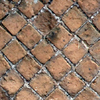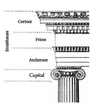Roman Architecture Flashcards
(137 cards)
Acanthus
A plant common to the Mediterranean, appearing often in such Roman architectural ornaments as the swirling vines of the Ara Pacis Augustae, and as rows of leaves in Corinthian and Composite capitals.
Adyton
A shrine on the interior altar of a Roman temple, as originally located in the Temple of Bacchus at Baalbek.
Aedicula (Aediculae)
Niches surrounded with temple-like columns and pediment. A profusion of them can be seen in the restored view of the Nymphaeum at Miletus.
Ala (Alae)
1) The “wings” of a Roman house where the shrines and images of family ancestors were kept; 2) The “wings” formed by the space between the outer walls of the cella and freestanding columns of some temples, most prominently the Temple of Mars Ultor in the Forum of Augustus in Rome.
Ambulatio
A walkway, for example at Tiberius’ Villa Jovis on Capri.
Annular Vault
A ring vault used in a wide variety of Roman buildings from sanctuaries to theatres. The Santuary of Fortuna Primigenia at Palestrina is one example.
Apodyterium
The dressing room in a Roman bath building with recesses in the wall for clothes, for example in the Stabian Baths at Pompeii.
Arcosolium (Arcosolia)
Large arcuated horizontal niche that contained a deceased body and was sealed by a marble slab, as in the interior of the Tomb of the Caetennii in the Vatican Cemetery.
Arcuated Lintel
An entablature that has been arched up in the center to create a more dramatic effect. Possibly used first in Syria, it was introduced into Roman architecture under Hadrian in such varied locations as Tivoli, Ephesus, and Athens.
Arena
Elongated oval-shaped space, surrounded by tiered seating, in an amphitheater and used to showcase various spectator events, as in Rome’s Colosseum.
Atrium (Atria)
The main room of a Roman house where the paterfamilias greeted clients and other important symbols of marriage and married life were displayed.
Atrium Testudinatum
An atrium without an opening in the ceiling.
Aula Regia
An audience hall in an imperial villa or palace, for example Tiberius’ Villa Jovis on Capri and Domitian’s Domus Augustana in Rome.
Barrel Vault
Vault shaped like a barrel, used in such varied locations as a market hall at Ferentino and an underground cryptoporticus at Arles.
Basalt
A volcanic rock, usually black or grey in color, although its hue may change with oxidation. Its weight made it a good choice in Roman antiquity for support at the base of a wall or a dome, as well as for street pavement stones.
Basilica
An elongated rectangular building with a central nave and side aisles, sometimes lighted by a clerestory. It was most often used for legal transactions, as at Pompeii, but is also an example of the “interchangeability of form” when utilized in another context, for example as a dining room in a Herculaneum house.
Bucranium (Bucrania)
Skull of a bull or ox, used as a decorative motif, often with garlands, as in the inner frieze of the precinct of Rome’s Ara Pacis Augustae.
Caldarium
The hot room or sauna in a Roman bath building, normally with a niche with basin for cold-water splashes. Rectangular or round, depending on chronological date, caldaria are preserved in the Forum Baths at Pompeii and the Baths of Caracalla in Rome.
Cardo
Main north south street of a Roman city, which intersected with the decumanus.
Caryatid
A sculptured female figure that replaced a column and supported an entablature, first used in Greece and then adopted by the Romans, appearing in such contexts as the Forum of Augustus in Rome and Hadrian’s villa at Tivoli.
Carystian Marble
Green-tinged marble from Carystos in Greece, used at such disparate sites as the Severan Forum at Leptis Magna and the Library of Hadrian in Athens.
Castrum
Roman military camp, the plan of which was adopted for Roman town planning, and can be seen at Ostia in its earliest formulation.
Cavea
Semicircular seating of Roman theatres and amphitheaters, as in the Theater at Orange.
Cella (Cellae)
1) The central space of a temple, for example, the Temple of Mars Ultor in Rome and the Capitolium at Ostia; 2) The rectangular spaces at the front of a Roman house that could be opened up as the tabernae or kept closed from the street and used as additional interior residential quarters.


















